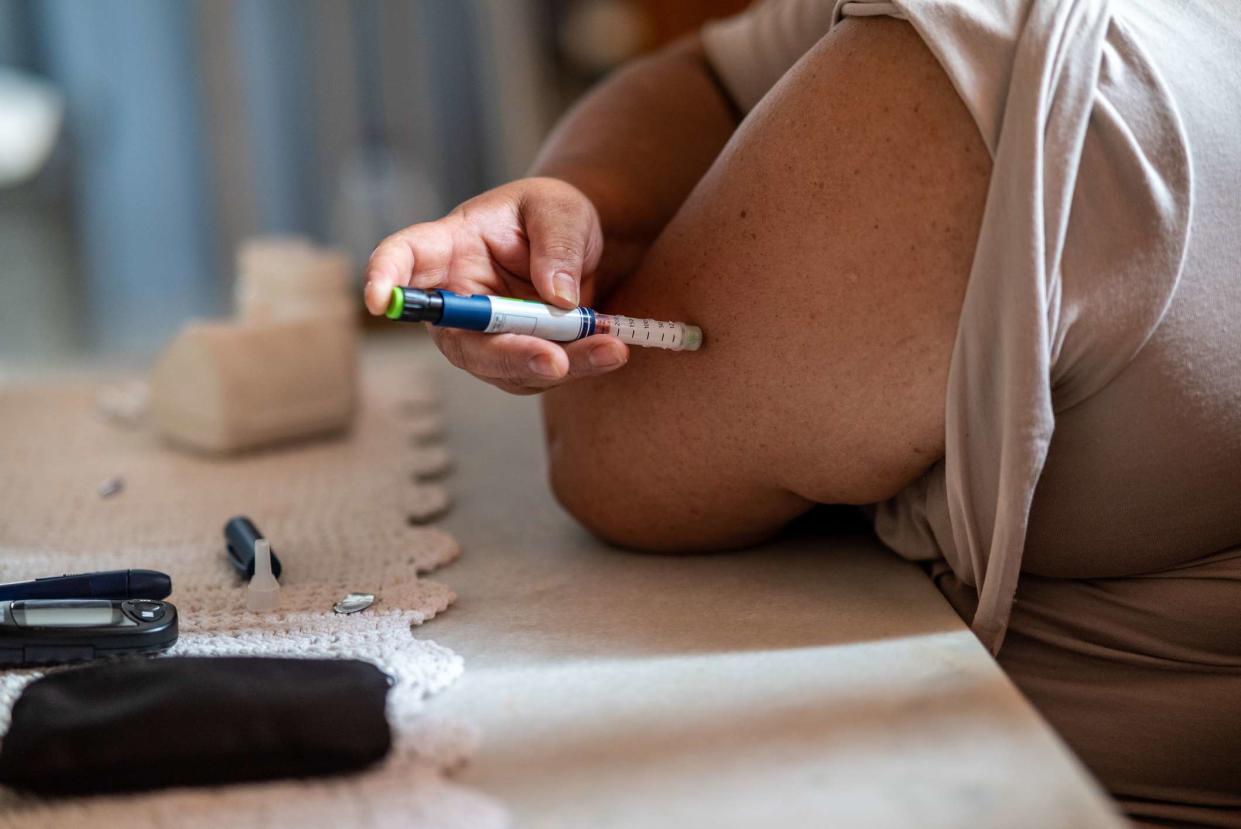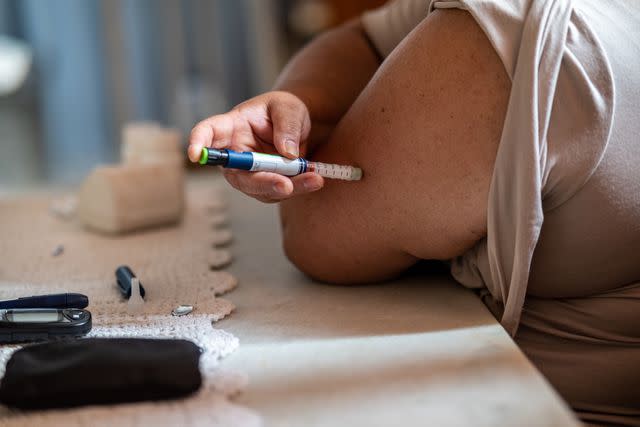Insulin Prices: How to Manage High Costs

CaÃque de Abreu / Getty Images
Since 1999, insulin injection prices have risen over 1000%—from about $20 to more than $300 a vial. Studies show more than a million people spend about 40% of their income after rent and daily expenses on insulin. About 20% of Americans who take insulin injections might ration their medication, such as skipping doses or taking less than prescribed. This can lead to dire complications like amputations, heart disease, kidney failure, and vision issues.
This article covers insulin prices, factors that affect them, and how to lower insulin costs for yourself.

CaÃque de Abreu / Getty Images
Why You Need Insulin
Insulin is produced in the pancreas, an organ next to the stomach. Type 1 diabetes occurs when someone's pancreas cannot produce insulin, while type 2 diabetes is when the body doesn't produce enough insulin or doesn't process the insulin that is available. Lack of insulin can raise blood sugar in the body, which, if left untreated, can lead to heart disease, stroke, kidney failure, nerve damage, amputations, and/or blindness.
If you are in urgent need of insulin, head to your local emergency department immediately. Skipping or rationing insulin doses can increase the chances of kidney failure, amputation, and death, even in younger people.
All three major insulin manufacturers offer patient assistance programs, including emergency supplies. Their hotline numbers are:
Novo Nordisk: 1-844-NOVO4ME
Sanofi: 1-855-984-6302
Lilly: 1-833-808-1234
NeedyMeds, RxHope, American Diabetes Association, Inside Rx, and Mat.org are some non-profit organizations that could guide you to resources for maintaining your insulin.
Taking prescription insulin regulates blood sugar after meals or throughout someone's day, depending on the patient. Skipping insulin doses or taking less than the recommended daily dose can be risky. This includes a risk of amputations, kidney failure, and death, even for younger people (who are also more likely to skip their insulin).
Average Prices
The price of insulin can depend on the type of insulin and your personal needs. Insulin is normally measured in units. For example, eating 60 grams of carbohydrates might require six units of insulin. There are 100 units per milliliter (ml) of insulin, and vials of insulin usually measure 3ml or 10 ml.
In 2018, the average price of a vial of insulin ranged from about $70 to $120, with some vials in the $300 to $400 range and others as high as $1800.
The US federal government and 22 state governments have passed laws to cap insulin costs. For instance, the 2022 Inflation Reduction Act capped insulin copays at $35 for those on Medicare, the health insurance program for people aged 65 or older, some people with disabilities, and people with severe kidney disease. State-mandated insulin copay caps can range from $25 to $100 a month. However, self-insured plans, like many plans chosen by employees at large companies, are excluded.
In March 2023, the drugmakers Eli Lilly, Novo Nordisk, and Sanofi each announced they would be lowering the cost of their insulin products. These include price reductions for Humalog (Lilly), Lantus (Sanofi), and NovoLog (Novo Nordisk), and other insulins from each company. Each manufacturer also announced they would be capping out-of-pocket costs for insulin at $35 per month. Eli Lilly's price changes will take effect by the end of 2023, and the changes for Novo Nordisk and Sanofi will go into effect on January 1, 2024.
Some commonly prescribed types of insulin and their average prices per vial (300 units) are:
Rapid-acting: Starts working minutes after injection, lasts up to four hours. Brand names include Fiasp and NovoLog; $120
Short-acting/Regular: Begins working within 30 minutes and works for up to six hours. Brands include Novolin R, and Velosulin R; $90
Intermediate-acting: Starts working about an hour after injection and can last for up to a day. Brands include Protaphane; $70
Mixed: A combination of short or rapid-acting insulin and intermediate-acting insulin. Brand names include NovoMix and Mixtard; $100 to $110
Long-acting: Takes several hours to begin working and lasts about a day; $90
Factors That Affect Insulin Prices
Insurance and where you live can affect how much you pay for insulin.
Insurance
Here are some ways insurance could affect insulin costs:
Medicare beneficiaries: Copays of $35/month as of January 2023
Private insurance plan holders:
$25 to $100/month in states that have copay limit mandates for plans regulated by the state.
For states without mandates or for plans that are not regulated by the state (such as employee self-selected plans), prices can depend on your insurance plan's prescription drug coverage and deductible.
Uninsured: Cash prices can depend on brand, pharmacy, available discounts, and state mandates.
Medicaid: States with Medicaid programs usually cover insulin but might limit brand names and specialty formulas.
Where You Live
Whether or not there are state copay limit mandates for insulin can affect how much you could pay for insulin. Some states provide pharmaceutical assistance programs or emergency insulin assistance programs to help residents with costs. Insulin is more expensive in the United States than in other countries.
Country | Price per Vial |
United States | $98.70 |
Australia | $6.94 |
Canada | $12.00 |
France | $9.08 |
Germany | $11.00 |
Japan | $14.40 |
United Kingdom | $7.52 |
32 other countries in the Organisation for Economic Co-operation and Development, a world trade organization | $8.81 |
How to Lower Out-of-Pocket Costs
Whether or not you have insurance, there are ways to lower the price of insulin for yourself.
Buying in Bulk
Buying insulin in bulk and opting for syringes instead of pens could help save on insulin costs. However, do check state limits on how much insulin you can buy at one time.
Online pharmacies, including insulin from Amazon, can help with buying in insulin bulk. To make sure a website is a safe source for buying insulin, look for a he National Association of Boards of Pharmacy’s (NABP) Verified Internet Pharmacy Practice Sites Seal, or VIPPS Seal, according to the Food and Drug Administration (FDA).
Buying Generics
Ask your pharmacist about switching to generics to save. If you're paying cash without insurance, insulin brands usually offer "authorized generics" produced by their own companies. Some authorized generics might not be covered by insurance, however, they may be cheaper.
Some authorized generics include:
Lispro, a generic version of Humalog, from manufacturer Lilly
Insulin Aspart and Insulin Aspart Mix, generic versions of Novolog and Novolog Mix, from manufacturer Novo Nordisk
Assistance and Discounts
Some ways to get assistance for discounted or no-cost medications include:
Insulin manufacturer hotlines and patient assistance programs
Medicare.gov's Pharmaceutical Companies Assistance Programs search tool
Federally-funded local clinics
Rx Assist
Walmart and CVS
Asking your pharmacist about discount cards from pharmacies and manufacturers
Flexible Spending Accounts
If you have health insurance through a job, a flexible spending account (FSA) is a tax-free health spending account you and your employer can contribute to, with a limit of $3050 per year. FSAs can reimburse you for out-of-pocket costs for insulin. Ask your employer for how to submit reimbursements for insulin costs that aren't covered by insurance.
Summary
There are ways to save on insulin costs, even without insurance. These include buying generics, manufacturer discount hotlines that could provide emergency low-cost supplies, local federally-funded clinics, non-profits like NeedyMeds and GoodRx, and state prescription assistance programs.
If you are insured by an employer, flexible spending accounts can also help cover insulin costs. Pharmacy discount cards, buying in bulk, and asking your local vendorr, whether that be Walmart or CVS (both of which provide $25-dollar insulin), for discount programs can also help.
A Word from Verywell
It can seem daunting to manage an insulin prescription, but the good news is help is available. An emergency room can provide urgently needed insulin, however, patient assistance program hotlines from insulin manufacturers, federally-funded local clinics, and discount programs via your pharmacy or doctor are just some ways to maintain your recommended dose.
Frequently Asked Questions
Why are insulin prices so high?
Reasons why insulin prices are so high include a 2003 law that bans Medicare from negotiating drug prices, lack of equal insurance coverage for all Americans, pharmacy benefit mangers (people who manage negotiations between pharmacies and manufacturers), and that 60 votes are required in the United States Senate for a nationwide $35/a month copay cap on insulin to become law. In addition, three companies control 96% of the global insulin market.
Lack of knowledge about programs like copay cards from drug manufacturers or about cheaper insulin available at pharmacies can also be why some people spend more than they might need to on their insulin.
How much does insulin cost to make?
A 2018 study found a vial of insulin costs approximately $2 to $6 to make. A one-year supply of insulin would cost about $50 to $130 if patients were charged only for manufacturing.

